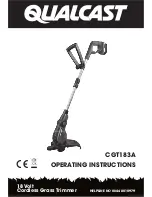
5 ENGLISH
19.
Take a rest to prevent loss of control caused
by fatigue.
We recommend to take a 10 to
20-minute rest every hour.
20.
Hold the power tool by insulated gripping
surfaces only, because the cutting attachment
may contact hidden wiring.
Cutting attachments
contacting a “live” wire may make exposed metal
parts of the power tool “live” and could give the
operator an electric shock.
21.
Do not use the tool on steep slopes.
22.
When performing the edging operation, hold
and move the tool as instructed in this manual
to prevent an injury due to flying debris or
stones.
23.
The shoulder harness must be used during
operation, if supplied with the tool.
Maintenance instructions
1.
The condition of the nylon cutting head, pro-
tective devices must be checked before com-
mencing work.
2.
Turn off the motor and remove the battery
cartridge before carrying out maintenance,
replacing the nylon cutting head or nylon cord
and cleaning the tool.
3.
Check for loose fasteners and damaged parts
such as cracks in the nylon cutting head.
4.
Follow instructions for lubricating and chang-
ing accessories if applicable.
5.
When not in use store the equipment in an
indoor dry location that is locked up or out of
children's reach.
6.
Use only the manufacturer's recommended
replacement parts and accessories.
7.
Inspect and maintain the tool regularly, espe-
cially before/after use. Have the tool repaired
only by our authorized service center.
8.
Keep handles dry, clean and free from oil and
grease. Keep all cooling air inlets clear of
debris.
9.
Always keep the tool in good working condi-
tion.
Poor maintenance can result in inferior per-
formance and shorten the life of the tool.
SAVE THESE INSTRUCTIONS.
WARNING:
DO NOT let comfort or familiarity
with product (gained from repeated use) replace
strict adherence to safety rules for the subject
product. MISUSE or failure to follow the safety
rules stated in this instruction manual may cause
serious personal injury.
WARNING:
Use of this product can create
dust containing chemicals which may cause
respiratory or other illnesses. Some examples of
these chemicals are compounds found in pesti-
cides, insecticides, fertilizers and herbicides.
Your risk from these exposures varies, depend-
ing on how often you do this type of work. To
reduce your exposure to these chemicals: work
in a well ventilated area, and work with approved
safety equipment, such as those dust masks that
are specially designed to filter out microscopic
particles.
Symbols
The followings show the symbols used for tool.
volts
direct current
no load speed
revolutions or reciprocation per minute
Important safety instructions for
battery cartridge
1.
Before using battery cartridge, read all instruc-
tions and cautionary markings on (1) battery char-
ger, (2) battery, and (3) product using battery.
2.
Do not disassemble or tamper with the battery
cartridge.
It may result in a fire, excessive heat,
or explosion.
3.
If operating time has become excessively
shorter, stop operating immediately. It may
result in a risk of overheating, possible burns
and even an explosion.
4.
If electrolyte gets into your eyes, rinse them out
with clear water and seek medical attention right
away. It may result in loss of your eyesight.
5.
Do not short the battery cartridge:
(1)
Do not touch the terminals with any con-
ductive material.
(2)
Avoid storing battery cartridge in a con-
tainer with other metal objects such as
nails, coins, etc.
(3)
Do not expose battery cartridge to water
or rain.
A battery short can cause a large current
flow, overheating, possible burns and even a
breakdown.
6.
Do not store and use the tool and battery car-
tridge in locations where the temperature may
reach or exceed 50 °C (122 °F).
7.
Do not incinerate the battery cartridge even if
it is severely damaged or is completely worn
out. The battery cartridge can explode in a fire.
8.
Do not nail, cut, crush, throw, drop the battery
cartridge, or hit against a hard object to the
battery cartridge.
Such conduct may result in a
fire, excessive heat, or explosion.
9.
Do not use a damaged battery.
10.
The contained lithium-ion batteries are subject to
the Dangerous Goods Legislation requirements.
For commercial transports e.g. by third parties,
forwarding agents, special requirement on pack-
aging and labeling must be observed.
For preparation of the item being shipped, consulting an
expert for hazardous material is required. Please also
observe possibly more detailed national regulations.
Tape or mask off open contacts and pack up the
battery in such a manner that it cannot move
around in the packaging.






































